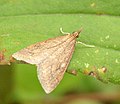| Crambidae | |
|---|---|

| |
| Scoparia ambigualis | |
| Scientific classification | |
| Domain: | Eukaryota |
| Kingdom: | Animalia |
| Phylum: | Arthropoda |
| Class: | Insecta |
| Order: | Lepidoptera |
| Superfamily: | Pyraloidea |
| Family: | Crambidae Latreille, 1810 |
| Type species | |
| Phalaena pascuella | |
| Subfamilies | |
|
see text | |
| Diversity | |
| Some 10,347 species | |
Crambidae comprises the grass moth family of lepidopterans. They are variable in appearance, with the nominal subfamily Crambinae (grass moths) taking up closely folded postures on grass stems where they are inconspicuous, while other subfamilies include brightly coloured and patterned insects that rest in wing-spread attitudes.
In many classifications, the Crambidae have been treated as a subfamily of the Pyralidae or snout moths. The principal difference is a structure in the tympanal organs called the praecinctorium, which joins two tympanic membranes in the Crambidae, and is absent from the Pyralidae. The latest review by Munroe and Solis, in Kristensen (1999), retains the Crambidae as a full family. The family currently comprises 15 subfamilies with altogether 10,347 species in over 1,000 genera.[1]
Systematics[edit]
| Cladogram of Crambidae subfamilies | |||
| |||
| Crambidae phylogeny after Regier et al. (2012) and Léger et al. (2021)[2][1] |
- subfamilia incertae sedis
- Conotalis Hampson, 1919
- Exsilirarcha Salmon & Bradley, 1956
- Subfamily Acentropinae Stephens, 1836
- Subfamily Crambinae Latreille, 1810
- Subfamily Erupinae Munroe, 1995[1]
- Subfamily Glaphyriinae Forbes, 1923 (= Evergestinae Marion, 1952, Noordinae Minet, 1980,[2] Cybalomiinae Marion, 1955, Cathariinae Minet, 1982[1])
- Subfamily Heliothelinae Amsel, 1961
- Subfamily Hoploscopinae Robinson et al., 1994[1]
- Subfamily Lathrotelinae Clarke, 1971[3]
- Subfamily Linostinae Amsel, 1956
- Subfamily Midilinae Munroe, 1958
- Subfamily Musotiminae Meyrick, 1884
- Subfamily Odontiinae Guenée, 1854
- Subfamily Pyraustinae Meyrick, 1890
- Subfamily Schoenobiinae Duponchel, 1846
- Subfamily Scopariinae Guenée, 1854
- Subfamily Spilomelinae Guenée, 1854 (= Wurthiinae Roepke, 1916)[2]
Relationship with humans[edit]
Since crambids are relatively common throughout human settlements, the moths tend to affect crops and gardens, whether harmfully, beneficially or harmlessly. Beneficial crambids include the water hyacinth moth (Niphograpta albiguttalis), used to control its host (Eichhornia crassipes),[4] the water veneer (Acentria ephemerella), a biocontrol agent used against Eurasian watermilfoil,[5] and the bamboo borer (Omphisa fuscidentalis), of which the caterpillars are used for human consumption. The mint moth (Pyrausta aurata) is an example of a harmless crambid.
Crambid larvae are typically stem borers in plants of the grass family. As this family contains many important crops, some Crambidae species achieve pest status. The European corn borer Ostrinia nubilalis is perhaps the best known; introduced to the United States in the early 1900s, it is now widespread in all but the westernmost states. Other pest species include the pearl millet stem borer (Coniesta ignefusalis), the spotted stalk borer (Chilo partellus), the Asiatic rice borer (Chilo suppressalis), sod webworms (Crambus spp.), Duponchelia fovealis, the sugarcane borer (Diatraea saccharalis), bean pod borers (Maruca spp.), the rice white stemborer (Scirpophaga innotata), the southwestern corn borer (Diatraea grandiosella), and the grape leaffolder (Desmia maculalis).
Gallery[edit]
-
Spilomelinae species
-
Agriphila straminella on Achillea
-
Herpetogramma sp.
See also[edit]
References[edit]
- ^ a b c d e Léger, Théo; Mally, Richard; Neinhuis, Christoph; Nuss, Matthias (2020). "Refining the phylogeny of Crambidae with complete sampling of subfamilies (Lepidoptera, Pyraloidea)". Zoologica Scripta. 50 (1): 84–99. doi:10.1111/zsc.12452.
- ^ a b c Regier, J. C., C. Mitter, M. A. Solis, J. E. Hayden, B. Landry, M. Nuss, T. J. Simonsen, S.-H. Yen , A. Zwick & M. P. Cummings 2012: A molecular phylogeny for the pyraloid moths (Lepidoptera: Pyraloidea) and its implications for higher-level classification. Archived 2016-03-05 at the Wayback Machine – Systematic Entomology, London 37 (4): 635–656.
- ^ Minet, J. 2015: Lathrotelidae Clarke, 1971: a rehabilitated name deserving subfamily rank (Lepidoptera, Crambidae). – Bulletin de la Société entomologique de France, Paris 120 (1): 109–112.
- ^ McLeod, Robin (April 24, 2016). "Species Niphograpta albiguttalis - Water Hyacinth Moth - Hodges#5149". BugGuide. Archived from the original on May 1, 2019. Retrieved February 5, 2020.
- ^ McLeod, Robin (February 1, 2019). "Species Acentria ephemerella - Water Veneer - Hodges#5299". BugGuide. Archived from the original on May 1, 2019. Retrieved February 5, 2020.
Further reading[edit]
- Kristensen, N.P. (Ed.). 1999. Lepidoptera, Moths and Butterflies. Volume 1: Evolution, Systematics, and Biogeography. Handbuch der Zoologie. Eine Naturgeschichte der Stämme des Tierreiches / Handbook of Zoology. A Natural History of the phyla of the Animal Kingdom. Band / Volume IV Arthropoda: Insecta Teilband / Part 35: 491 pp. Walter de Gruyter, Berlin, New York.
External links[edit]
- "Family Crambidae". Insecta.pro
- Synclita obliteralis, waterlily leafcuter on the UF / IFAS Featured Creatures Web site
- Diatraea saccharalis, sugarcane borer
- Grape Leaffolder Moth Cirrus Digital
- McLeod, Robin (December 18, 2016). "Family Crambidae - Crambid Snout Moths". BugGuide. Retrieved April 11, 2018.






